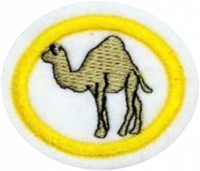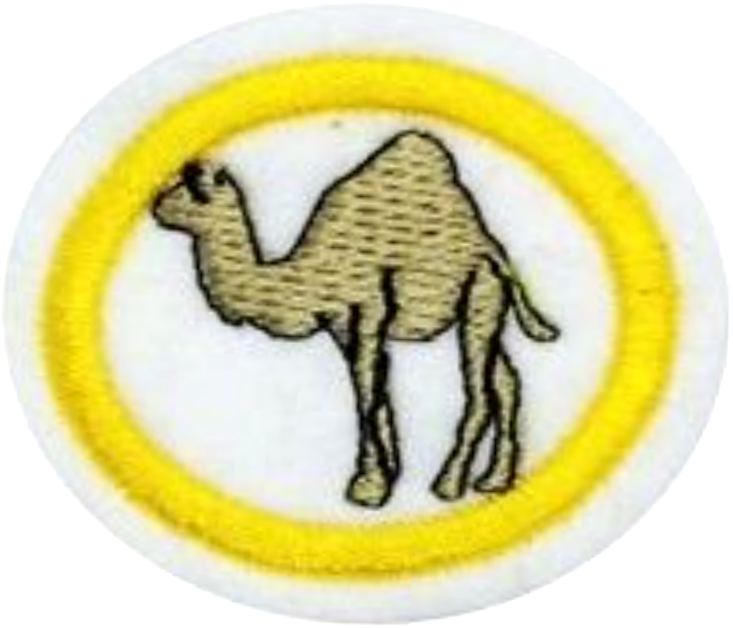Especialidades JA/Camelos/Respostas
1
Bactrian
- two hump
- Cold climates Much more northern climate than the dromedary including the Siberian steppe and the cold, arid deserts of Central and Eastern Asia. In the winter, temperatures in their native habitat can drop as low as –29° Celsius (–20° F).
- long, shaggy coat that helps protect them in the cold winter months. They shed their long fur in the summer, when they are faced with high temperatures
- typically dark brown to beige in coloring,
- wide feet that facilitate walking across snow and sand, but their feet are tougher and can stand up to their more rocky environment
- one or two babies (although one is much more common) and continue nursing them for up to a year and a half. The young aren’t completely independent until they’re five years old, thought they can bear young of their own between three and five years.
- Much rarer, severely threatened in the wild
The domesticated Bactrian camel has served as a pack animal in inner Asia since ancient times. With its tolerance for cold, drought, and high altitudes, it enabled travel such as the caravans of the Silk Road.The wild form has dwindled with limited remaining populations. ts range in the wild is restricted to remote regions of the Gobi and Taklamakan Deserts of Mongolia and China, migrating from the desert to rivers in Siberia during winter. A small number of wild Bactrian camels still roam the Mangystau Province of southwest Kazakhstan and the Kashmir valley in India. There are feral herds of Bactrian camels in Australia.
The two types are sometimes bred together, producing an even bigger, stronger camel useful for plowing and other work. Camel wrestling (a sport where male camels are exposed to an in heat female and then allowed to fight each other) almost exclusively uses cross bred camels.
Recent research suggests that wild camels may be another species, possessing a different number of chromosomes.
2
2a
2b
2c
2d
3
3a
3b
3c
3d
4
The domesticated alpaca and llama are not endangered. They have been exported to many countries in the world and in the US and Canada at least, supply exceeds demand.
5
6
There are about 59 total verses that reference camel(s), camel hair and a camel saddle in the Bible. Here are all of them grouped chronologically:
Jacob acquired camels Genesis 30:43 and used them for riding and as pack animals Genesis 31:17 and Genesis 32:7
United Kingdom
David's practice was to take plunder, including camels according to 1 Samuel 27:9
Four hundred young Amalekite men escaped David's band by riding off on camels in 1 Samuel 30:17-18
1 Chronicles 12:40 says that "neighbors from as far away as Issachar, Zebulun and Naphtali came bringing food on donkeys, camels, mules and oxen" while David's army was growing.
1 Chronicles 27:30 "Obil the Ishmaelite was in charge of the camels" for King David.
The Queen of Sheba (modern Ethiopia) used camels as pack animals in 1 Kings 10:2 and the parallel account in 2 Chronicles 9:1 when she came to see King Solomon.
Divided Kingdom, Exile and Return
2 Kings 8:9 says that "Hazael went to meet Elisha, taking with him as a gift forty camel-loads of all the finest wares of Damascus. He went in and stood before him, and said, “Your son Ben-Hadad king of Aram has sent me to ask, ‘Will I recover from this illness?’”"
King Asa's army when fighting the Cushites in 2 Chronicles 14:15 "also attacked the camps of the herders and carried off droves of sheep and goats and camels."
Isaiah 21:7 mentions riders on camels. Isaiah 30:5-7 says "A prophecy concerning the animals of the Negev: Through a land of hardship and distress, of lions and lionesses, of adders and darting snakes, the envoys carry their riches on donkeys’ backs, their treasures on the humps of camels, to that unprofitable nation, to Egypt, whose help is utterly useless. Therefore I call her Rahab the Do-Nothing."
Isaiah 60:6 mentions "Herds of camels will cover your land, young camels of Midian and Ephah." and Isaiah 66:20 proposes people will come on camels to Jerusalem to worship.
Jeremiah 2:22-24 compares Israel to a sexually excited "swift she-camel running here and there"! Now that's a graphic metaphor.
Jeremiah writes in Jeremiah 49 that the Kedar and the kingdoms of Hazor, which Nebuchadnezzar king of Babylon attacked will lose their camels.
Ezra's band of returning exiles had "736 horses, 245 mules, 435 camels and 6,720 donkeys." Ezra 2:66-67 and Nehemiah 7:69
Ezekiel 25:5 predicts that "I will turn Rabbah into a pasture for camels and Ammon into a resting place for sheep. Then you will know that I am the Lord."
Zechariah 14:15 says that a plague will strike the livestock, including camels, of the enemies of the Lord.
New Testament
In Mark 1:6 and Matthew 3:4 John the Baptist's clothes were made of camel’s hair, and he had a leather belt around his waist.
In Matthew 19:24, Mark 10:25 and Luke 18:25 Jesus says that "Again I tell you, it is easier for a camel to go through the eye of a needle than for someone who is rich to enter the kingdom of God.” (see Question 6 above)
Matthew 23:24 Jesus says "You blind guides! You strain out a gnat but swallow a camel."




